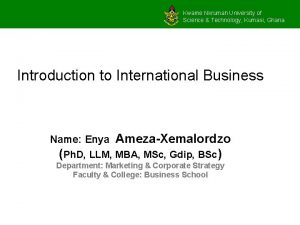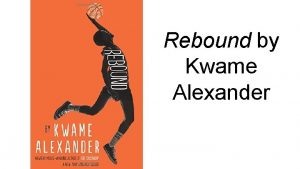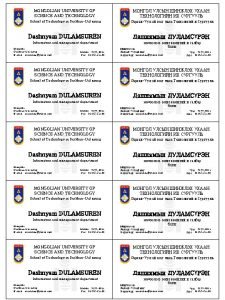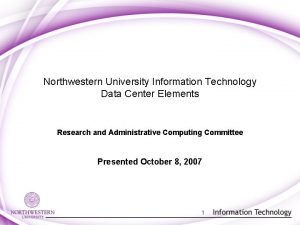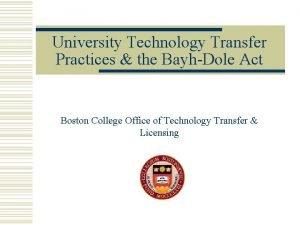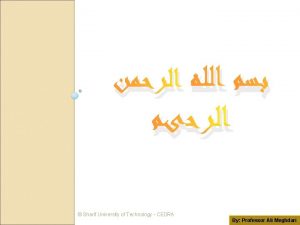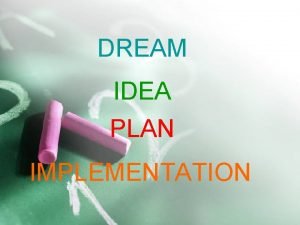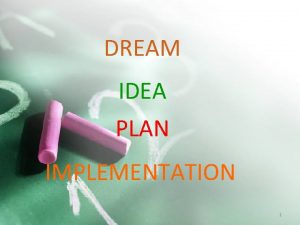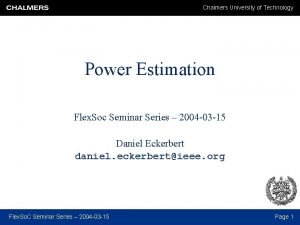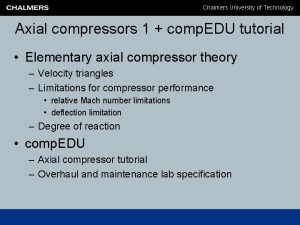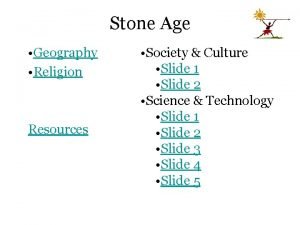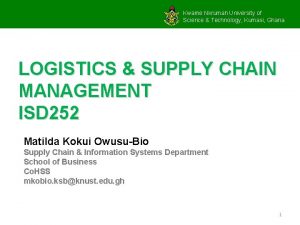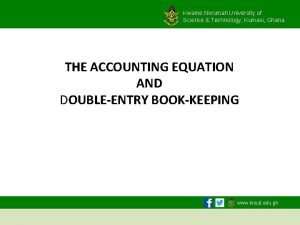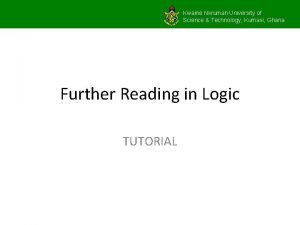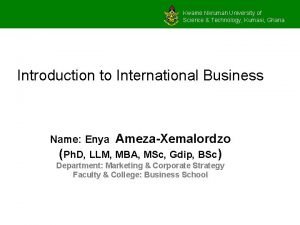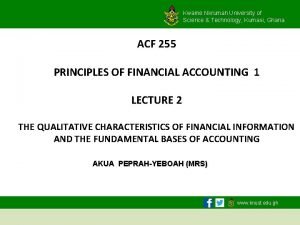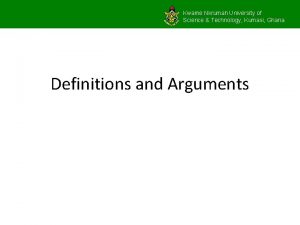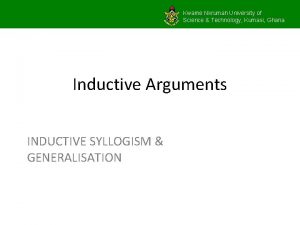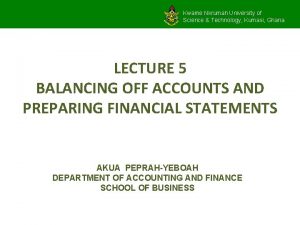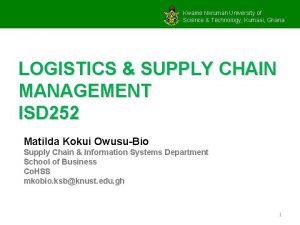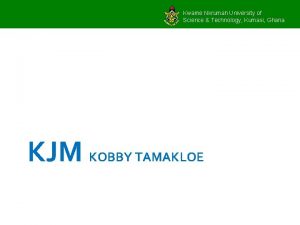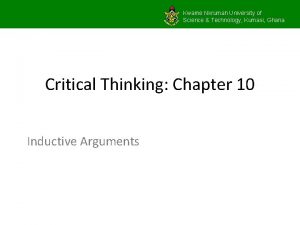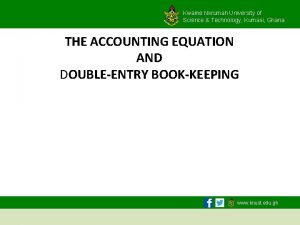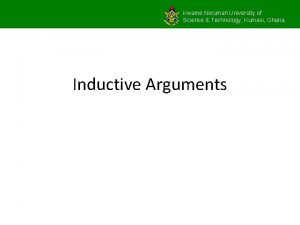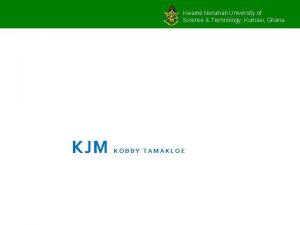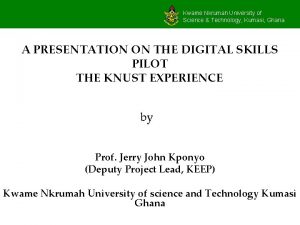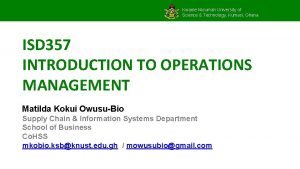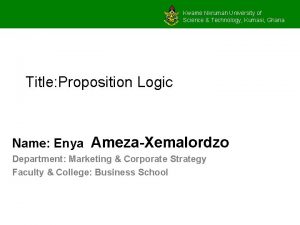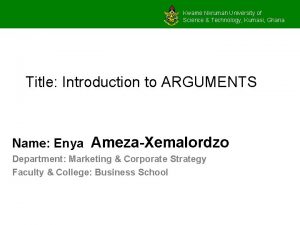Kwame Nkrumah University of Science Technology Kumasi Ghana

















![EXAMPLE: INCOME STATEMENT Entity ABC Income statement for the year ended [date] GHȻ GHȻ EXAMPLE: INCOME STATEMENT Entity ABC Income statement for the year ended [date] GHȻ GHȻ](https://slidetodoc.com/presentation_image_h/296b1de92a61ab84011b11be855802e8/image-18.jpg)
![Entity ABC Statement of financial position as at [date] Assets $ Non‐current assets: Land Entity ABC Statement of financial position as at [date] Assets $ Non‐current assets: Land](https://slidetodoc.com/presentation_image_h/296b1de92a61ab84011b11be855802e8/image-19.jpg)








































- Slides: 59

Kwame Nkrumah University of Science & Technology, Kumasi, Ghana LECTURE 5 BALANCING OFF ACCOUNTS AND PREPARING FINANCIAL STATEMENTS AKUA PEPRAH-YEBOAH DEPARTMENT OF ACCOUNTING AND FINANCE SCHOOL OF BUSINESS

1 CAPITAL 16 F BROWN BANK 100, 000 4, 000 2 OFFICE FURNITURE 4 VAN 1, 200 6, 010 24 CASH 400 6 TREES LTD 1, 400 26 B BLANE 2, 000 8 MACHINERY 10 VAN 14 DREAMS LTD 650 5, 250 1, 780 15 CASH 17 VAN 20 CASH 22 CARTON CARS 130 6, 400 180 7, 100 25 OFFICE FIXTURES 480 29 CASH 200 30 B BLANE 500 www. knust. edu. gh

1 CAPITAL 16 F BROWN BANK 100, 000 4, 000 2 OFFICE FURNITURE 4 VAN 1, 200 6, 010 24 CASH 400 6 TREES LTD 1, 400 26 B BLANE 2, 000 BAL B/D 106, 400 75, 120 8 MACHINERY 10 VAN 14 DREAMS LTD 650 5, 250 1, 780 15 CASH 17 VAN 20 CASH 22 CARTON CARS 130 6, 400 180 7, 100 25 OFFICE FIXTURES 480 29 CASH 200 30 B BLANE BAL C/D 500 75, 120 106, 400 www. knust. edu. gh

VAN 4 BANK 10 BANK 17 BANK 19 CARTON CARS 6, 010 5, 250 6, 400 7, 100 BAL C/D 24, 760 D TWIG AND SONS 5 OFFICE FURNITURE 150 7 CASH 150 www. knust. edu. gh

VAN 4 BANK 10 BANK 17 BANK 19 CARTON CARS BAL B/D 6, 010 5, 250 6, 400 7, 100 2 4, 760 BAL C/D 24, 760 D TWIG AND SONS 5 OFFICE FURNITURE 150 7 CASH 150 www. knust. edu. gh

BAL C/D CAPITAL 100, 000 1 BANK BAL B/D 2 BANK 9 DREAM LIMITED OFFICE FURNITURE 1, 200 5 D TWIG AND SONS 1, 900 12 DREAM LTD BAL B/D 100, 000 BAL C/D 3, 100 2, 830 150 120 2, 830 100 www. knust. edu. gh

3 TREES LIMITED 8 BANK BAL B/D MACHINERY 1, 400 BAL C/D 650 2, 050 6 BANK TREES LTD 1, 400 3 MACHINERY 1, 400 www. knust. edu. gh

7 D TWIG AND SONS 13 EQUIPMENT 15 BANK 20 BANK 23 B BERRY 29 BANK BAL B/D CASH 150 21 OFFICE FIXTURES 200 24 BANK 130 27 COMPUTER 180 BALC/D 500 200 1, 360 240 120 400 600 240 1, 360 www. knust. edu. gh

9 OFFICE FURNITURE 14 BANK BAL C/D DREAM LTD 120 12 OFFICE FURNITURE 1, 780 1, 900 PEARCE AND SONS 2, 300 11 EQUIPMENT BAL B/D 1, 900 2, 300 2300 www. knust. edu. gh

11 PEARCE AND SONS BAL B/D EQUIPMENT 2, 300 13 CASH 2, 300 2, 100 BAL C/D 200 2, 100 2, 300 F BROWN BAL C/D 4, 000 16 BANK BAL B/D 4, 000 www. knust. edu. gh

BAL C/D 28 CLEARCOUNT BAL B/D CLEAR COUNT 420 28 DISPLAY EQUIPMENT 420 BAL B/D 420 DISPLAY EQUIPMENT 420 BAL C/D 420 COMPUTER 27 CASH BAL B/D 600 BAL C/D 600 www. knust. edu. gh

B BLANE 30 BANK BAL C/D 500 26 BANK 1, 500 2, 000 BAL B/D 22 BANK 2, 000 CARTON CARS 7, 100 19 VAN 1, 500 7, 100 www. knust. edu. gh

OFFICE FIXTURES 18 OLD 900 21 CASH 120 25 BANK BAL B/D 480 1, 500 BAL C/D 1, 500 www. knust. edu. gh

6 BAL C/D OLD LTD 900 3 OFFICE FIXTURES BAL B/D 900 B BERRY BAL C/D 500 23 CASH BAL B/D 500 www. knust. edu. gh

Trial balance CAPITAL OFFICE FURNITURE BANK MACHINERY CASH PEARCE & SONS EQUIPMENT F BROWN VAN CLEAR COUNT DISPLAY EQUIPMENT COMPUTER B BLANE OLD OFFICE FIXTURES B BERRY 100, 000 2, 830 75, 120 2, 050 240 2, 300 2, 100 4, 000 24, 760 420 600 1, 500 900 1, 500 109, 620 www. knust. edu. gh

NOTE: For all expenses and income, balances are transferred to the income statement and so the Bal c/d is not used. Rather a double entry transfer is done. Dr/Cr account in question, Dr/Cr income statement. In the trial balance however, all balances are shown, regardless of whether they are shown in the statement of financial position or transferred to the income statement www. knust. edu. gh

Example: Post the following into the appropriate accounts, balance them off and prepare a trial balance. Capital contributed is $2, 000 cash Bought goods worth $200 for cash Sold goods for $300 for cash Bought furniture for $400 Bought equipment for $300 www. knust. edu. gh
![EXAMPLE INCOME STATEMENT Entity ABC Income statement for the year ended date GHȻ GHȻ EXAMPLE: INCOME STATEMENT Entity ABC Income statement for the year ended [date] GHȻ GHȻ](https://slidetodoc.com/presentation_image_h/296b1de92a61ab84011b11be855802e8/image-18.jpg)
EXAMPLE: INCOME STATEMENT Entity ABC Income statement for the year ended [date] GHȻ GHȻ Revenue 800, 000 Cost of sales 500, 000 Gross profit 300, 000 Other income: Gain on disposal of non‐current asset 10, 000 310, 000 Expenses Employees’ salaries 120, 000 Depreciation 10, 000 Rental costs 30, 000 Telephone charges 15, 000 Advertising costs 30, 000 Selling costs 40, 000 General expenses 20, 000 Interest charges 3, 000 Bad debts 2, 000 270, 000 Net profit 40, 000 www. knust. edu. gh
![Entity ABC Statement of financial position as at date Assets Noncurrent assets Land Entity ABC Statement of financial position as at [date] Assets $ Non‐current assets: Land](https://slidetodoc.com/presentation_image_h/296b1de92a61ab84011b11be855802e8/image-19.jpg)
Entity ABC Statement of financial position as at [date] Assets $ Non‐current assets: Land buildings 400, 000 Plant and equipment 100, 000 Motor vehicles 80, 000 580, 000 Current assets: Inventory 20, 000 Receivables 30, 000 Cash 5, 000 55, 000 Total assets 635, 000 Equity and liabilities Equity: Owner’s capital 440, 000 Non‐current liabilities: Bank loan 170, 000 Current liabilities: Bank overdraft 10, 000 Trade payables 15, 000 25, 000 Total equity and liabilities 635, 000 www. knust. edu. gh

From trial balance to final accounts Adjustments 1. Inventory 2. Accruals and prepayments 3. Depreciation calculations 4. Provisions www. knust. edu. gh

Inventory Opening and Closing Inventory and the Cost of Sales In an income statement, the gross profit for a period = Sales – Cost of sales. The accruals concept is applied, and sales are matched with the cost of making those sales in order to calculate gross profit. However costs of purchases during a period are not the same as the cost of sales, because of changes in inventory levels. The Cost of Sales = Opening inventory + Purchases – Closing inventory. $ Opening inventory A Purchases B A + B Closing inventory (C) Cost of sales A + B – C The cost of sales is shown in an income statement, and is used to calculate the gross profit (or loss) earned during an accounting period.

Example Here is an illustrative example. $ Sales 183, 000 Opening inventory 15, 000 Purchases 100, 000 115, 000 Closing inventory (20, 000) Cost of sales (95, 000) Gross profit 88, 000 Other expenses (80, 000) Net profit (or loss) for the period 8, 000

Recording opening and closing inventory In order to prepare an income statement, it is therefore necessary to obtain values for opening inventory and closing inventory, and to record these in the accounting system. There are two main methods of recording inventory, a continuous inventory system and a period‐end system. There is a ledger account (in the main ledger) for inventory. In a period‐end system, inventory is normally valued just once each year, at the end of the financial year. The value of inventory at the end of one year (i. e. closing inventory) becomes the opening inventory at the beginning of the next year. Until the end of the year, the balance on the inventory account (a debit balance) is the value of opening inventory at the beginning of the year. At the end of the financial year, the closing inventory is counted and valued. The opening inventory value is replaced in the inventory account by the value of closing inventory, in the way described below. The appropriate book‐keeping entries in the main ledger are as follows:

Period-end method: accounting procedures For the opening inventory • Credit the inventory account with the value of the opening inventory • Debit the income statement with the value of the opening inventory. The income statement (as well as the inventory account) is an account in the main ledger, and is part of the double entry book‐keeping system. • For the closing inventory • Debit the inventory account with the value of the closing inventory • Credit the income statement with the value of the closing inventory.

The closing balance on the inventory account is therefore the value of the closing inventory, which is carried forward as the opening balance at the beginning of the next period. The end‐of‐year adjustments for inventory are shown in the T account below. Inventory account Current year $ Opening inventory b/f A Income statement B Closing inventory c/f B A + B Next year Opening inventory b/f B In a period-end system, all purchases from suppliers are recorded in a Purchases account: Debit Purchases, Credit Trade payables.

Example In Year 2, Bubbles had opening inventory of $10, 000. Sales during the year were $80, 000 and purchases were $30, 000. Closing inventory at the end of Year 2 was $12, 000. The entries in the main ledger of Bubbles can be summarised as follows: www. knust. edu. gh

SALES Income statement 80, 000 Receivables/cash 80, 000 PURCHASES Cash/Payables 30, 000 Income statement 30, 000 INVENTORY ACCOUNT Opening inventory(Bal b/d) Income statement (Closing stock) 10, 000 Income statement (Opening stock) 10, 000 12, 000 Bal c/d 12, 000 22, 000 www. knust. edu. gh

www. knust. edu. gh

Carriage inwards and carriage outwards Two expenses that you might come across are carriage inwards and carriage outwards. Even though they are both expenses they are reported differently in the income statement.

Carriage inwards This is the cost a business might incur in getting its purchases delivered to its business premises. Sometimes the supplier may pay any delivery costs but if the business has to pay its own delivery costs it records these costs as carriage inwards. The double entry is: Debit Carriage inwards Credit Bank Cost of carriage inwards is part of the cost of bringing the inventory to its current location and condition. The cost is usually added to the purchase cost of the goods and so this cost is included in the cost of sales and the calculation of gross profit. www. knust. edu. gh

Carriage outwards is the cost of delivering goods to customers. This is a normal selling expense, which is treated as an expense in the income statement. The cost of carriage outwards is not included in the cost of inventory or cost of sales and so does not affect gross profit (only net profit). www. knust. edu. gh

PURCHASES AND SALES RETURNS In the calculation of Cost of Sales, Sales and Purchases are adjusted for any returns made during the year. Therefore, Revenue = Sales – Return Inwards And Purchases = Purchases – Return Outwards www. knust. edu. gh

Thus, gross profit is calculated as follows: GHȻ Sales XXXX Less Returns Inwards (XXX) GHȻ XXXX Less Cost of sales: Opening stock XXX Purchases XXX Less Returns Outwards (XX) Add Carriage Inwards XX Less Closing Stock GROSS PROFIT XXX (XX) (XXX) XXXX www. knust. edu. gh

OTHER INCOME After gross profit is calculated, income from other sources (gains from disposal of non current assets and income from other investments) are added to it. Gains on disposal are calculated as: Sales price of asses xxxx Cost of asset xxx Less depn (xxx) Profit/Loss xxx Other income include: Rent receivable Decrease in provisions Interest on investments All other incomes from sources other than the core business of the entity www. knust. edu. gh

EXPENSES www. knust. edu. gh

Accruals and prepayments According to the accrual concept, expenses should be matched against revenue for a particular accounting period. Thus, expenses should be fully charged for a particular year irrespective of how much has been actually paid. For example, if in a year GHȻ 3, 000 is paid as electricity but the electricity bill shows GHȻ 4, 000, an electricity expense of GHȻ 4, 000 is recognised in the income statement. Likewise if the bill showed GHȻ 2, 000, still an expense of GHȻ 4, 000 would be showed. This is because, the amount of electricity consumed this year in order to earn revenue is GHȻ 4, 000. An expense/income owing is said to be ACCRUED whiles an expense/income paid in advance is said to be PREPAID. www. knust. edu. gh

Kwame Nkrumah University of Science & Technology, Kumasi, Ghana Effect on profit Effect on the statement of financial position Accrued income and Prepaid expenses are treated as part of receivables. Accrued expenses and prepaid income are treated as part of payables.

Example In an accounting year, an entity paid GHȻ 3, 500 as electricity and GHȻ 5, 600 as rent. At the end of the year, the electricity bill showed an owing of GHȻ 300 and the rent for the year is GHȻ 5, 000. For the same year, interest income received was GHȻ 4, 000 with GHȻ 2, 000 still outstanding and the entity received fees for other jobs to the tune of GHȻ 5, 420 when jobs executed was worth GHȻ 2, 800. Show the rent, electricity, interest income and other income in the income statement and statement of financial position. www. knust. edu. gh

WORKINGS Electricity consumed in the year = GHȻ 3, 500+GHȻ 300 =GHȻ 3, 800 Rent expense incurred = GHȻ 5600 (even though only. GHȻ 5, 000 has been paid for) Interest received = GHȻ 4, 000 + GHȻ 2, 000 Other Income = GHȻ 2, 800 www. knust. edu. gh

INCOME STATEMENT EXTRACT Gross Profit Add other income: Interest received Other income XXX 6, 000 2, 800 8, 800 Less expenses Electricity Rent Expense 3, 800 5, 000 8, 800 www. knust. edu. gh

BALANCE SHEET EXTRACT Current Assets: Receivables Add Prepaid expenses: Rent (5, 600‐ 5, 000) Add accrued income: Interest income owing Current Liabilities Add Accrued expenses Electricity owing Other income repaid XXXX 600 2, 000 300 2, 620 www. knust. edu. gh

DEPRECIATION Deprecation is defined as that part of the original cost of a non‐current asset that is consumed during its period of use by the business. Each year, an amount is charged to the profit and loss account that represents the amount consumed in earning revenue (in accordance with the matching concept). Thus depreciation reduces profit. www. knust. edu. gh

METHODS OF CALCULATING DEPRECIATION CHARGES STRAIGHT LINE METHOD • In this method the number of years of use is estimated. The cost is then divided by the number of years. This gives the deprecation charge for each year. For instance if a van is bought for Ghc 22, 000 and we think that it will last for 4 years, and will be sold for Ghc 2, 000 the depreciation to be charged each year would be:

METHODS OF CALCULATING DEPRECIATION CHARGES REDUCING BALANCE METHOD In this method, a fixed percentage for depreciation is deducted from the cost in the first year. In the second year, and later years the same percentage is taken of the reduced balance (i. e. cost less depreciation already charged). • The method is also known as diminishing balance method or the diminishing debt balance method. If a machine for Ghc 10, 000 and deprecation is to be charged at 20%, the calculation for the first three years would be as follows: Ghc Cost First year 10, 000 Depreciation (20%) (2, 000) 8, 000 Second year Depreciation (20%) 1, 600 6, 400 Third year Cost not apportioned at end of 3 rd year Depreciation (20%) (1, 280) 5, 120

Depreciation and the final accounts • The calculation of depreciation for the accounting period is Debited to the Income statement as an expense and Credited to the accumulated depreciation account. Dr Income statement Cr Accumulated depreciation account The balance of the accumulated depreciation account is sent to the statement of financial position as a reduction in value of assets.

EXAMPLE Trial balance extract Dr Motor Van (cost) CR 30, 000 Accumulated depreciation 5, 000 Depreciation is calculated on a straight line basis for 12 years with no scrap value. Show the income statement and balance sheet extracts.


INCOME STATEMENT EXTRACT Gross profit xxxx Add other income xxx Less expenses: Depreciation (2, 500) STATEMENT OF FINANCIAL POSITION Non Current Assets: Cost Acc Depn NBV Motor Van 30, 000 7, 500 22, 500

PROVISIONS FOR DOUBTFUL DEBT A provision is an amount set aside for probable contingencies that might occur. One provision made is for debts that are likely to become bad. This is referred to as the provision for doubtful debt. The key thing to note here is that only increases or decreases in the provision are considered. Increase in provision: Dr Income statement Cr Provision for doubtful debt account Decrease in provision: Dr Provision for doubtful debt account Cr Income statement Thus, increases are treated as expenses whiles decreases are treated as gains (under other income). The balance of the doubtful debt account is sent to the SOFP as a reduction in receivables. www. knust. edu. gh

EXAMPLE AAM ltd made a provision for doubtful debts of 360 last year. It is their view that a larger provision is necessary for this accounting year. Therefore, the provision is increased to 420. The receivables balance for the year is 45, 000. Show the treatment in the income statement and statement of financial position. www. knust. edu. gh

INCOME STATEMENT Gross Profit XXXX Add other income xxx Less expenses: Increase in provision (420 ‐ 360) (60) STATEMENT OF FINANCIAL POSITION Non current Assets XXXX Current Assets: Receivables 45, 000 Less provision for doubtful debt ( 420) www. knust. edu. gh

INCOME STATEMENT Gross Profit XXXX Add other income xxx Less expenses: Increase in provision (420 ‐ 360) (60) STATEMENT OF FINANCIAL POSITION Non current Assets XXXX Current Assets: Receivables 45, 000 Less provision for doubtful debt ( 420) www. knust. edu. gh

SALES /REVENUE LESS RETURNS INWARDS LESS COST OF SALES OPENING STOCK ADD PURCHASES LESS RETURNS OUTWARDS ADD CARRIAGE INWARDS INCOME STATEMENT FOR THE YEAR ENDED …………………. . GHS XXX XXXX XXX XXX LESS CLOSING STOCK OTHER INCOME: RENT RECEIVABLE GAINS FROM DISPOSAL DECREASE IN PROVISION GROSS PROFIT XXXX (XXX) XXX XXX (XXXX) XXXXX LESS EXPENSES: RENT ADD ACCRUAL LESS PREPAYMENTS INCREASE IN PROVISION DEPRECIATION LOSS ON DISPOSAL NET PROFIT XXX XXX (XXX) XXXX www. knust. edu. gh

Classification of expenses Entities can decide to group expenses according to their similarities. Usually three groups are generated, namely: Administrative expenses Selling and distribution expenses Finance expenses www. knust. edu. gh

STATEMENT OF FINANCIAL POSITION FOR THE YEAR ENDED …………. NON CURRENT ASSETS MACHINERY AT COST LESS DEPRECIATION CURRENT ASSETS STOCK DEBTORS LESS PROVISION ADD PREPAYMENT BANK CASH GHS XXX XXX XXX (XXX) XXX XXX XXXXX CAPITAL ADD NET PROFIT LESS DRAWINGS XXXX (XXX) XXXX CURRENT LIABILITIES CREDITORS ADD ACCRUAL XXX XXXX NON CURRENT LIABILITIES LONG TERM LOANS XXX XXXXX www. knust. edu. gh

The following trial balance has been extracted from the ledger of Mr. Yousef, a sole trader. TRIAL BALANCE Sales Purchases Carriage Drawings Rent, rates and insurance Postage and stationery Advertising Salaries and wages Bad debts Provision for doubtful debts Debtors Creditors Cash in hand Cash at bank Stock as at 1 June 2016 Equipment At cost Accumulated depreciation Capital Dr £ 82, 350 5, 144 7, 800 6, 622 3, 001 1, 330 26, 420 877 12, 120 177 1, 002 11, 927 58, 000 216, 770 Cr £ 138, 078 130 6, 471 19, 000 53, 091 216, 770 www. knust. edu. gh

The following additional information as at 31 May 2016 is available: (a) Rent is accrued by £ 210. (b) Rates have been prepaid by £ 880. (c) £ 2, 211 of carriage represents carriage inwards on purchases. (d) Equipment is to be depreciated at 15% per annum using the straight line method. (e) The provision for doubtful debts to be increased by £ 40. (f) Stock at the close of business has been valued at £ 13, 551. Required: Prepare a trading and profit and loss account for the year ended 31 May 2017 and a balance sheet as at that date www. knust. edu. gh

SALES INCOME STATEMENT FOR THE YEAR ENDED 31 ST MARCH 2016 GHS 138, 078 LESS COST OF SALES OPENING STOCK ADD PURCHASES ADD CARRIAGE INWARDS 11, 927 82, 350 2, 211 84, 561 96, 488 LESS CLOSING STOCK GROSS PROFIT LESS EXPENSES: RENT POSTAGE ADVERTISEMENTS SALARIES AND WAGES (13, 551) 82, 937 55, 141 6622+ 210‐ 880 5, 952 3, 001 1, 330 26, 420 BAD DEBT 877 INCREASE IN PROVISION DEPRECIATION CARRIAGE OUTWORDS 40 8, 700 2, 933 49, 253 NET PROFIT 0. 15 X 58000 5144 ‐ 221 5, 888 www. knust. edu. gh

STATEMENT OF FINANCIAL POSITION FOR THE YEAR ENDED 31 ST MARCH 2016 GHS NON CURRENT ASSETS EQUIPMENT AT COST 58, 000 LESS DEPRECIATION (27, 700) 30, 300 CURRENT ASSETS STOCK DEBTORS LESS PROVISION ADD PREPAYMENT BANK CASH CAPITAL ADD NET PROFIT LESS DRAWINGS CURRENT LIABILITIES CREDITORS ADD ACCRUAL 13, 551 12, 120 (170) 11, 950 880 1, 002 177 27, 560 57, 860 53, 091 5, 888 (7, 800) 51, 179 6, 471 210 6, 681 57, 860 www. knust. edu. gh
 University of science and technology kumasi
University of science and technology kumasi Rebound by kwame alexander summary
Rebound by kwame alexander summary Booked kwame alexander summary
Booked kwame alexander summary Usth hanoi
Usth hanoi Spike unist internship
Spike unist internship Science and technology university yemen
Science and technology university yemen Jordan university of science and technology
Jordan university of science and technology Jordan university of science and technology
Jordan university of science and technology Jordan university of science and technology
Jordan university of science and technology University of shanghai for science and technology
University of shanghai for science and technology University of science and technology of mazandaran
University of science and technology of mazandaran Npust scholarship
Npust scholarship Mongolian university of science and technology logo
Mongolian university of science and technology logo National yunlin university of science and technology
National yunlin university of science and technology Think central k5
Think central k5 What is your favorite subject ?
What is your favorite subject ? Northwestern mailroom
Northwestern mailroom University of chemical technology prague
University of chemical technology prague University of chemical technology and metallurgy
University of chemical technology and metallurgy Eindhoven university of technology
Eindhoven university of technology Moscow state university of design and technology
Moscow state university of design and technology Thanyaburi technical college
Thanyaburi technical college Lublin university of technology
Lublin university of technology Henan university of technology (haut)
Henan university of technology (haut) Georgetown university communication culture and technology
Georgetown university communication culture and technology Neptune bme
Neptune bme Budapest university of technology and economics
Budapest university of technology and economics Bme 1782
Bme 1782 Slovak university of technology in bratislava
Slovak university of technology in bratislava Boston university technology transfer
Boston university technology transfer University of chemistry and technology prague tuition fee
University of chemistry and technology prague tuition fee Kazakh university of technology and business
Kazakh university of technology and business Tashkent information technology university
Tashkent information technology university Opole university of technology erasmus
Opole university of technology erasmus Sharif university of technology
Sharif university of technology Pec university of technology
Pec university of technology National research university of electronic technology
National research university of electronic technology Amirkabir university of technology logo
Amirkabir university of technology logo Amirkabir university of technology logo
Amirkabir university of technology logo Tallinn university library
Tallinn university library Military university of technology
Military university of technology Chalmers university of technology
Chalmers university of technology Chalmers university of technology
Chalmers university of technology Chalmers university of technology
Chalmers university of technology Babol te
Babol te Queensland university of technology
Queensland university of technology Pace university information technology
Pace university information technology Georgetown communication culture and technology
Georgetown communication culture and technology Georgetown university communication culture and technology
Georgetown university communication culture and technology Addis ababa university institute of technology
Addis ababa university institute of technology State council of science and technology
State council of science and technology Mail @ stcu.int
Mail @ stcu.int Masdar institute of science and technology
Masdar institute of science and technology Madhav institute of technology and science
Madhav institute of technology and science Technology definition science
Technology definition science Grade 4 nst term 3 practical task
Grade 4 nst term 3 practical task Nature of science technology and society
Nature of science technology and society Technology adverb form
Technology adverb form Stone age science and technology
Stone age science and technology Tufts science and technology center
Tufts science and technology center
